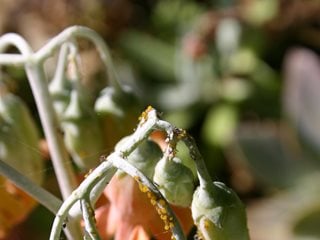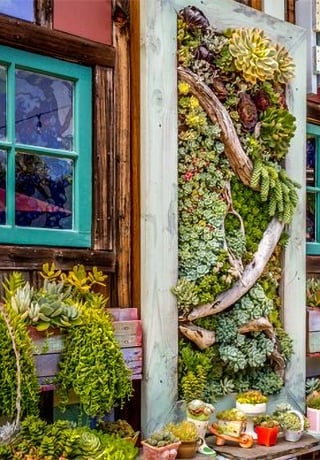Succulent Care: 5 Steps for Healthy Succulents
Learn how to grow succulents successfully in your own gardenThe secret to succulent care and growing them successfully is to give them conditions similar to their native habitats, which for the most part are warm, arid and receive minimal rainfall (under 20 inches a year).
On this page:1. Temperature
Although succulents can usually handle more rainfall than they’d get in their native habitat, their roots may rot if the soil stays soggy. Very few succulents thrive outdoors where temperatures drop below freezing (32 degrees F) for extended periods. Cold-hardy varieties are primarily fine-leaved, perennial stonecrops (Sedum sp.), and hens-and-chicks (Sempervivum sp.)—genera that also don’t do well in temps above 80 degrees.
2. Water & Fertilizer
The rule of thumb is to water succulents thoroughly once a week in summer, twice a month in spring and fall, and monthly during their winter dormancy. Keep succulents on the dry side, and give their roots superb drainage.
When under-watered, succulents subsist on stored moisture. If the soil dries completely, roots may desiccate and growth cease. Some succulents are capable of regenerating roots when the rains return, but it’s best to keep soil about as moist as a wrung-out sponge.
Increase or diminish the amount of water with these considerations:
- The type and depth of soil
- Time of year
- Relative humidity
- Intensity and duration of sun exposure
- Ambient temperature
- The type of plant
Apply a balanced liquid fertilizer, diluted to half strength, once or twice in spring (or autumn for summer-dormant varieties such as senecios and aeoniums).
3. Sun and shade

At the Desert Botanical Garden in Phoenix, a shade structure protects non-native cacti from frost and scorching sun.
Photo by: Debra Lee Baldwin
In general, give succulents half a day of full sun; ideally full sun in the morning and then bright or dappled shade the rest of the day. Keep in mind that the intensity and duration of sunlight varies according to latitude and elevation, throughout the seasons, and in different orientations and locations in your garden. Moreover, the same succulents that bask in full-day sun along the California coast may scorch in under 30 minutes in Arizona.
Varieties that will want more sun—and won’t bloom without it—are those native to the Southwest such as cacti and yuccas, and aloes from South Africa.
Succulents do need adequate light for balanced growth (so they don’t stretch), and any succulent—any plant for that matter—that has been cultivated in low-light or in a greenhouse should be hardened-off (introduced gradually) to greater sun exposure.
Here are a few things to keep in mind:
- Sunburn appears as permanent beige or brown patches, and if extensive, can kill the plant.
- Those few that don’t tolerate full sun, such as sansevierias and haworthias, make wonderful houseplants.
- Variegated (striped) succulents, which have less protective pigment, want less sun than their solid-colored cousins.
4. Soil and drainage

Pumice is a volcanic rock with air pockets that absorb excess moisture and enhance aeration.
Photo by: Debra Lee Baldwin
The best soil for succulents, whether in the ground or in containers, is a coarse, fast-draining mix. You can buy bagged cactus mix, but it’s less expensive to make your own.
Although soil types vary from region to region and even within your own garden, the basic formula for in-ground plantings is:
- One-third garden soil
- One third compost
- One third pumice
If you’re growing primarily desert succulents, reduce the amount of compost and add sharp (large-grained) sand, such as builder’s sand or decomposed granite. If your native soil drains poorly (typical of clay), avoid having roots sit in water by planting atop the clay in raised beds or mounded soil.
For containers, mix any bagged potting soil half-and-half with pumice. Increase the percentage of pumice for cacti and rotund euphorbias, and decrease it for fine-leaved succulents, such as sedums.
5. Pest control
Prevent infestations by giving succulents excellent air circulation. Aphids and thrips like flower buds; scale tends to colonize stems; and mealybugs (which look like bits of lint) burrow into leaf axils.
Spray pests with 70% rubbing alcohol diluted 50% with water. Scale can be scraped off, but if it persists, treat it with horticultural soap (not dish soap) and horticultural oil. Isolate any infested plants immediately to keep the pests from spreading, and thoroughly clean the area.
Mold may be a problem in humid climates; keep succulents as dry as possible (which sounds easy, but of course isn’t).
If pests seem to be winning, take cuttings from unaffected growth and establish them in fresh soil. Discard the diseased plant, soil and all, and clean the pot before reusing.
Can't grow succulents outdoors where you live?
The banana belt for outdoor cultivation of succulents year-round is coastal California from the Bay Area south. But no matter where you live, you can have any succulent you fancy; simply grow the fussy ones in sheltered microclimates or containers. Succulents, being shallow-rooted, thrive in pots that can be moved and sheltered when the weather turns too hot, cold or wet. And even potentially enormous succulents tend to stay small when their roots are confined.
At my home, an outdoor countertop is a great location for succulents that I prefer not to grow in the open garden.
RELATED:
Succulent Container Gardens
Water-Wise Gardens
Succulent Q&A







